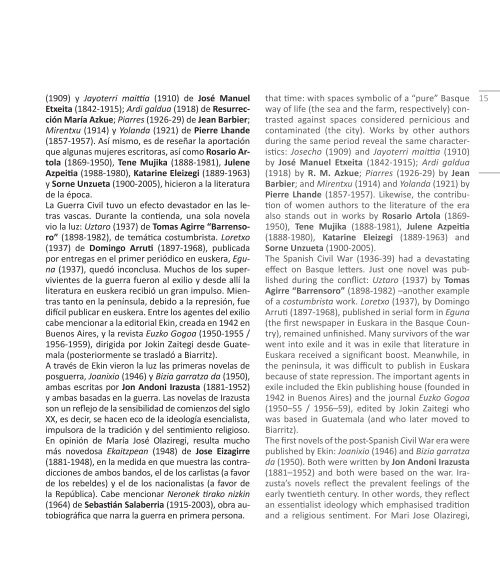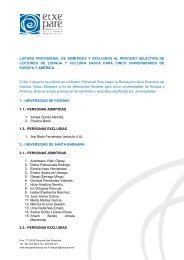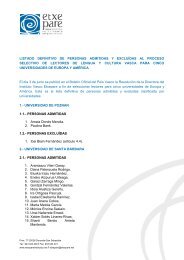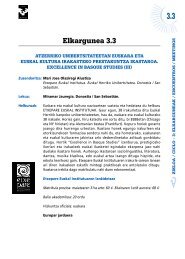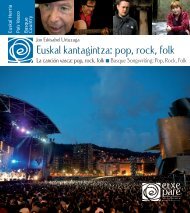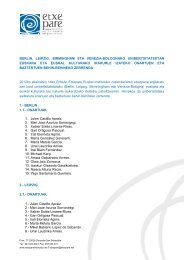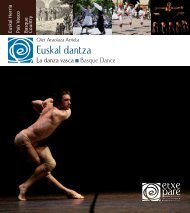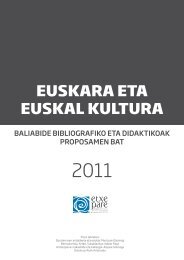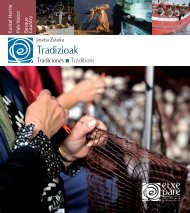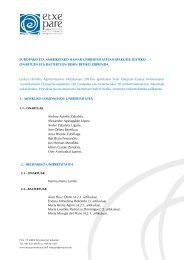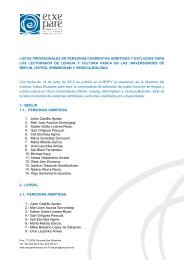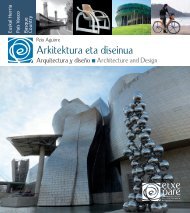XX. mendeko euskal literatura - Etxepare, Euskal Institutua
XX. mendeko euskal literatura - Etxepare, Euskal Institutua
XX. mendeko euskal literatura - Etxepare, Euskal Institutua
Create successful ePaper yourself
Turn your PDF publications into a flip-book with our unique Google optimized e-Paper software.
(1909) y Jayoterri maittia (1910) de José Manuel<br />
Etxeita (1842-1915); Ardi galdua (1918) de Resurrección<br />
María Azkue; Piarres (1926-29) de Jean Barbier;<br />
Mirentxu (1914) y Yolanda (1921) de Pierre Lhande<br />
(1857-1957). Así mismo, es de reseñar la aportación<br />
que algunas mujeres escritoras, así como Rosario Artola<br />
(1869-1950), Tene Mujika (1888-1981), Julene<br />
Azpeitia (1988-1980), Katarine Eleizegi (1889-1963)<br />
y Sorne Unzueta (1900-2005), hicieron a la <strong>literatura</strong><br />
de la época.<br />
La Guerra Civil tuvo un efecto devastador en las letras<br />
vascas. Durante la contienda, una sola novela<br />
vio la luz: Uztaro (1937) de Tomas Agirre “Barrensoro”<br />
(1898-1982), de temática costumbrista. Loretxo<br />
(1937) de Domingo Arruti (1897-1968), publicada<br />
por entregas en el primer periódico en euskera, Eguna<br />
(1937), quedó inconclusa. Muchos de los supervivientes<br />
de la guerra fueron al exilio y desde allí la<br />
<strong>literatura</strong> en euskera recibió un gran impulso. Mientras<br />
tanto en la península, debido a la represión, fue<br />
difícil publicar en euskera. Entre los agentes del exilio<br />
cabe mencionar a la editorial Ekin, creada en 1942 en<br />
Buenos Aires, y la revista Euzko Gogoa (1950-1955 /<br />
1956-1959), dirigida por Jokin Zaitegi desde Guatemala<br />
(posteriormente se trasladó a Biarritz).<br />
A través de Ekin vieron la luz las primeras novelas de<br />
posguerra, Joanixio (1946) y Bizia garratza da (1950),<br />
ambas escritas por Jon Andoni Irazusta (1881-1952)<br />
y ambas basadas en la guerra. Las novelas de Irazusta<br />
son un reflejo de la sensibilidad de comienzos del siglo<br />
<strong>XX</strong>, es decir, se hacen eco de la ideología esencialista,<br />
impulsora de la tradición y del sentimiento religioso.<br />
En opinión de María José Olaziregi, resulta mucho<br />
más novedosa Ekaitzpean (1948) de Jose Eizagirre<br />
(1881-1948), en la medida en que muestra las contradicciones<br />
de ambos bandos, el de los carlistas (a favor<br />
de los rebeldes) y el de los nacionalistas (a favor de<br />
la República). Cabe mencionar Neronek tirako nizkin<br />
(1964) de Sebastián Salaberria (1915-2003), obra autobiográfica<br />
que narra la guerra en primera persona.<br />
that time: with spaces symbolic of a “pure” Basque<br />
way of life (the sea and the farm, respectively) contrasted<br />
against spaces considered pernicious and<br />
contaminated (the city). Works by other authors<br />
during the same period reveal the same characteristics:<br />
Josecho (1909) and Jayoterri maittia (1910)<br />
by José Manuel Etxeita (1842-1915); Ardi galdua<br />
(1918) by R. M. Azkue; Piarres (1926-29) by Jean<br />
Barbier; and Mirentxu (1914) and Yolanda (1921) by<br />
Pierre Lhande (1857-1957). Likewise, the contribution<br />
of women authors to the literature of the era<br />
also stands out in works by Rosario Artola (1869-<br />
1950), Tene Mujika (1888-1981), Julene Azpeitia<br />
(1888-1980), Katarine Eleizegi (1889-1963) and<br />
Sorne Unzueta (1900-2005).<br />
The Spanish Civil War (1936-39) had a devastating<br />
effect on Basque letters. Just one novel was published<br />
during the conflict: Uztaro (1937) by Tomas<br />
Agirre “Barrensoro” (1898-1982) –another example<br />
of a costumbrista work. Loretxo (1937), by Domingo<br />
Arru ti (1897-1968), published in serial form in Eguna<br />
(the first newspaper in Euskara in the Basque Country),<br />
remained unfinished. Many survivors of the war<br />
went into exile and it was in exile that literature in<br />
Euskara received a significant boost. Meanwhile, in<br />
the peninsula, it was difficult to publish in Euskara<br />
because of state repression. The important agents in<br />
exile included the Ekin publishing house (founded in<br />
1942 in Buenos Aires) and the journal Euzko Gogoa<br />
(1950–55 / 1956–59), edited by Jokin Zaitegi who<br />
was based in Guatemala (and who later moved to<br />
Biarritz).<br />
The first novels of the post-Spanish Civil War era were<br />
published by Ekin: Joanixio (1946) and Bizia garratza<br />
da (1950). Both were written by Jon Andoni Irazusta<br />
(1881–1952) and both were based on the war. Irazusta’s<br />
novels reflect the prevalent feelings of the<br />
early twentieth century. In other words, they reflect<br />
an essentialist ideology which emphasised tradition<br />
and a religious sentiment. For Mari Jose Olaziregi,<br />
15


